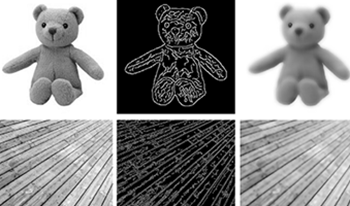References
1NavonD.1977Forest before trees: The precedence of global features in visual perceptionCogn. Psychol.9353383353–8310.1016/0010-0285(77)90012-3
2RouseD. M.HemamiS. S.Natural image utility assessment using image contours16th IEEE Int’l. Conf. on Image Processing (ICIP)2009IEEEPiscataway, NJ221722202217–20
3WangZ.BovikA. C.Modern Image Quality Assessment (Synthesis Lectures on Image, Video, and Multimedia Processing)2006Morgan ClaypoolSan Rafael, CA
4LeszczukM. I.StangeI.FordC.Determining image quality requirements for recognition tasks in generalized public safety video applications: Definitions, testing, standardization, and current trendsIEEE Int’l. Symposium on Broadband Multimedia Systems and Broadcasting (BMSB)2011IEEEPiscataway, NJ151–5
5MovshonJ. A.SimoncelliE. P.Representation of naturalistic image structure in the primate visual cortexCold Spring Harbor Symposia on Quantitative Biology2014Vol. 79Cold Spring HarborNY, USA115122115–22
6AloimonosJ.1988Shape from textureBiol. Cybern.58345360345–6010.1007/BF00363944
7KenderJ. R.Shape from texture: An aggregation transform that maps a class of textures into surface orientationProc. 6th Int’l. Joint Conf. on Artificial Intelligence1979Vol. 1Morgan Kaufmann Publishers Inc.Burlington, MA, USA475480475–80
8LiC.BovikA. C.2009Three-component weighted structural similarity indexProc. SPIE7242191–9
9SharanL.LiuC.RosenholtzR.AdelsonE. H.2013Recognizing materials using perceptually inspired featuresInt. J. Comput. Vis.103348371348–7110.1007/s11263-013-0609-0
10XuL.LinW.MaL.ZhangY.FangY.NganK. N.LiS.YanY.2016Free-energy principle inspired video quality metric and its use in video codingIEEE Trans. Multimedia18590602590–60210.1109/TMM.2016.2525004
11HubelD. H.WieselT. N.1962Receptive fields, binocular interaction and functional architecture in the cat’s visual cortexJ. Physiol.160106154106–5410.1113/jphysiol.1962.sp006837
12HubelD. H.WieselT. N.1968Receptive fields and functional architecture of monkey striate cortexJ. Physiol.195215243215–4310.1113/jphysiol.1968.sp008455
13BrincatS. L.ConnorC. E.2004Underlying principles of visual shape selectivity in posterior inferotemporal cortexNature Neurosci.788010.1038/nn1278
14PriebeN. J.FersterD.2012Mechanisms of neuronal computation in mammalian visual cortexNeuron75194208194–20810.1016/j.neuron.2012.06.011
15RiesenhuberM.PoggioT.1999Hierarchical models of object recognition in cortexNature Neurosci.210.1038/14819
16BaeS.ParisS.DurandF.Two-scale tone management for photographic lookACM Transactions on Graphics (TOG)2006Vol. 25ACMNew York, NY, USA637645637–45
17ParisS.DurandF.2009A fast approximation of the bilateral filter using a signal processing approachInt. J. Comput. Vis.81245224–5210.1007/s11263-007-0110-8
18DurandF.DorseyJ.Fast bilateral filtering for the display of high-dynamic-range imagesACM Transactions on Graphics (TOG)2002Vol. 21ACMNew York, NY, USA257266257–66
19ShottonJ.BlakeA.CipollaR.2008Multiscale categorical object recognition using contour fragmentsIEEE Trans. Pattern Anal. Mach. Intell.30127012811270–8110.1109/TPAMI.2007.70772
20BiedermanI.JuG.1988Surface versus edge-based determinants of visual recognitionCogn. Psychol.20386438–6410.1016/0010-0285(88)90024-2
21WinterJ. D.WagemansJ.2004Contour-based object identification and segmentation: Stimuli, norms and data, and software toolsBehav. Res. Methods Instrum. Comput.36604624604–2410.3758/BF03206541
22DalalN.TriggsB.Histograms of oriented gradients for human detectionIEEE Computer Society Conf. on Computer Vision and Pattern Recognition, 2005. CVPR 20052005Vol. 1IEEEPiscataway, NJ886893886–93
23ZhaiY.NeuhoffD. L.PappasT. N.Local radius index-a new texture similarity featureIEEE Int’l. Conf. on Acoustics, Speech and Signal Processing (ICASSP)2013IEEEPiscataway, NJ143414381434–8
24RouseD. M.PepionR.HemamiS. S.Le CalletP.2009Image utility assessment and a relationship with image quality assessmentProc. SPIE7240724010
25VaradarajanS.KaramL. J.A reduced-reference perceptual quality metric for texture synthesisIEEE Int’l. Conf. on Image Processing (ICIP)2014IEEEPiscataway, NJ531535531–5
26GolestanehS. A.SubedarM. M.KaramL. J.2015The effect of texture granularity on texture synthesis qualityProc. SPIE9599959912
27VaradarajanS.KaramL. J.A no-reference perceptual texture regularity metricIEEE Int’l. Conf. on Acoustics, Speech and Signal Processing (ICASSP)2013IEEEPiscataway, NJ189418981894–8
28BoscE.PepionR.Le CalletP.KoppelM.Ndjiki-NyaP.PressigoutM.MorinL.2011Towards a new quality metric for 3-d synthesized view assessmentIEEE Journal of Selected Topics in Signal Processing5133213431332–43IEEEPiscataway, NJ
29
30GolestanehS.KaramL. J.2016Reduced-reference quality assessment based on the entropy of dwt coefficients of locally weighted gradient magnitudesIEEE Trans. Image Process.25529353035293–30310.1109/TIP.2016.2601821
31LarsonE. C.ChandlerD. M.2010Most apparent distortion: full-reference image quality assessment and the role of strategyJ. Electronic Imaging1901100610.1117/1.3267105
32WangZ.SimoncelliE. P.BovikA. C.Multiscale structural similarity for image quality assessmentConf. Record of the Thirty-Seventh Asilomar Conf. on Signals, Systems and Computers, 20042003Vol. 2IEEEPiscataway, NJ139814021398–402
33SheikhH. R.BovikA. C.2006Image information and visual qualityIEEE Trans. Image Process.15430444430–4410.1109/TIP.2005.859378
34ScottE. T.HemamiS. S.Image utility estimation using difference-of-gaussian scale spaceIEEE Int’l. Conf. on Image Processing (ICIP)2016IEEEPiscataway, NJ101105101–5
35GolestanehS. A.KaramL. J.Reduced-reference synthesized-texture quality assessment based on multi-scale spatial and statistical texture attributesIEEE Int’l. Conf. on Image Processing (ICIP)2016IEEEPiscataway, NJ378337863783–6
36WangZ.SimoncelliE. P.Translation insensitive image similarity in complex wavelet domainProc. IEEE Int’l. Conf. on Acoustics, Speech, and Signal Processing (ICASSP’05)2005Vol. 2IEEEPiscataway, NJii573ii–573
37BrooksA. C.ZhaoX.PappasT. N.2008Structural similarity quality metrics in a coding context: Exploring the space of realistic distortionsIEEE Trans. Image Process.17126112731261–7310.1109/TIP.2008.926161
38Siddalinga SwamyD.
39MoorthyA. K.BovikA. C.2009Visual importance pooling for image quality assessmentIEEE J. Sel. Top. Signal Process.3193201193–20110.1109/JSTSP.2009.2015374
40ConzeP. H.2012Objective view synthesis quality assessmentProc. SPIE828853
41BattistiF.BoscE.CarliM.CalletP. L.PerugiaS.2015Objective image quality assessment of 3d synthesized viewsSignal Process, Image Commun.30788878–8810.1016/j.image.2014.10.005
42Sandić-StankovićD.KukoljD.Le CalletP.Dibr synthesized image quality assessment based on morphological waveletsSeventh Int’l. Workshop on Quality of Multimedia Experience (QoMEX)2015IEEEPiscataway, NJ161–6
43Sandic-StankovicD.KukoljD.Le CalletP.Dibr synthesized image quality assessment based on morphological pyramids3DTV-Conf.: The True Vision-Capture, Transmission and Display of 3D Video (3DTV-CON)2015IEEEPiscataway, NJ141–4
44FehnC.2004Depth-image-based rendering (dibr), compression, and transmission for a new approach on 3d-tvProc. SPIE52919310493–104
45TeleaA.2004An image inpainting technique based on the fast marching methodJ. Graphics Tools9233423–3410.1080/10867651.2004.10487596
46MoriY.FukushimaN.YendoT.FujiiT.TanimotoM.2009View generation with 3d warping using depth information for ftvSignal Process. Image Commun.24657265–7210.1016/j.image.2008.10.013
47MuellerK.SmolicA.DixK.MerkleP.KauffP.WiegandT.2009View synthesis for advanced 3d video systemsEURASIP J. Image Video Process.20081111–11
48Ndjiki-NyaP.KoppelM.DoshkovD.LakshmanH.MerkleP.MullerK.WiegandT.2011Depth image-based rendering with advanced texture synthesis for 3-d videoIEEE Trans. Multimedia13453465453–6510.1109/TMM.2011.2128862
49KöppelM.Ndjiki-NyaP.DoshkovD.LakshmanH.MerkleP.MüllerK.WiegandT.Temporally consistent handling of disocclusions with texture synthesis for depth-image-based renderingIEEE 17th Int’l. Conf. on Image Processing2010IEEEPiscataway, NJ180918121809–12
50Sandić-StankovićD.KukoljD.CalletP. L.2016Dibr-synthesized image quality assessment based on morphological multi-scale approachEURASIP J. Image Video Process.2017410.1186/s13640-016-0124-7
51LingS.Le CalletP.Image quality assessment for free viewpoint video based on mid-level contours featureIEEE Int’l. Conf. on Multimedia and Expo (ICME)2017IEEEPiscataway, NJ798479–84
52LingS.Le CalletP.CheungG.Quality assessment for synthesized view based on variable-length context treeIEEE 19th Int’l. Workshop on Multimedia Signal Processing (MMSP)2017IEEEPiscataway, NJ161–6
53LingS.Le CalletP.Image quality assessment for dibr synthesized views using elastic metricProc. ACM on Multimedia Conf.2017ACMNew York, NY, USA115711631157–63
54RaiY.AldahdoohA.LingS.BarkowskyM.Le CalletP.Effect of content features on short-term video quality in the visual peripheryIEEE 18th Int’l. Workshop on Multimedia Signal Processing (MMSP)2016IEEEPiscataway, NJ161–6

 Find this author on Google Scholar
Find this author on Google Scholar Find this author on PubMed
Find this author on PubMed